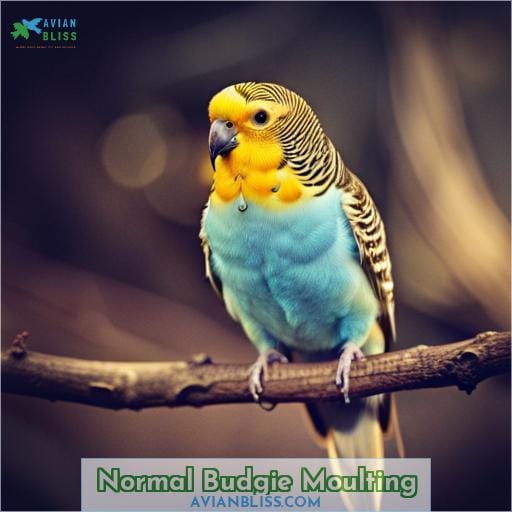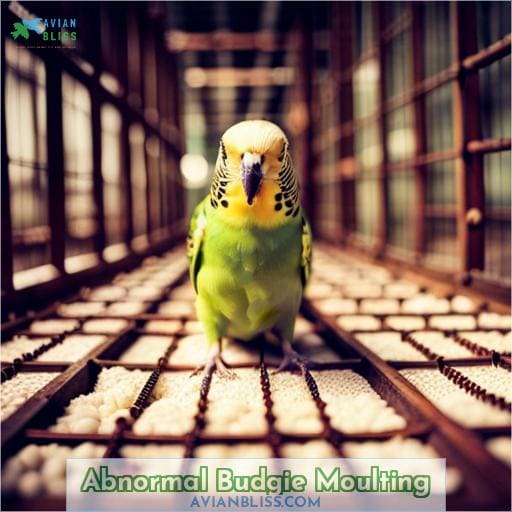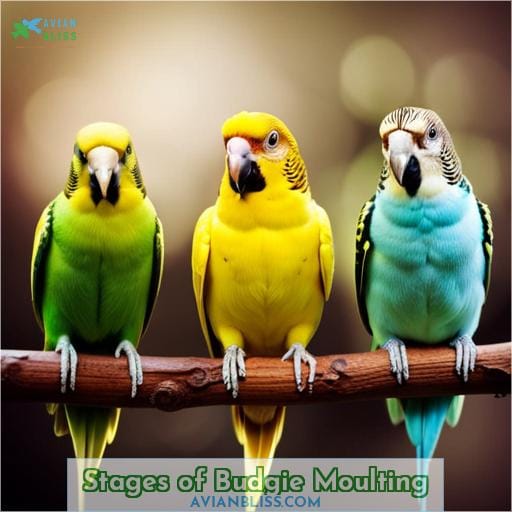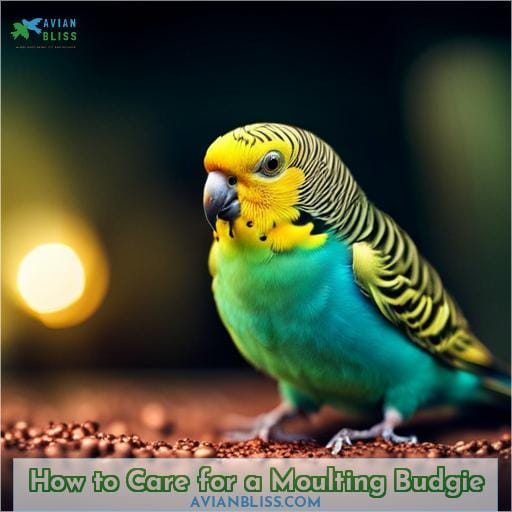This site is supported by our readers. We may earn a commission, at no cost to you, if you purchase through links.
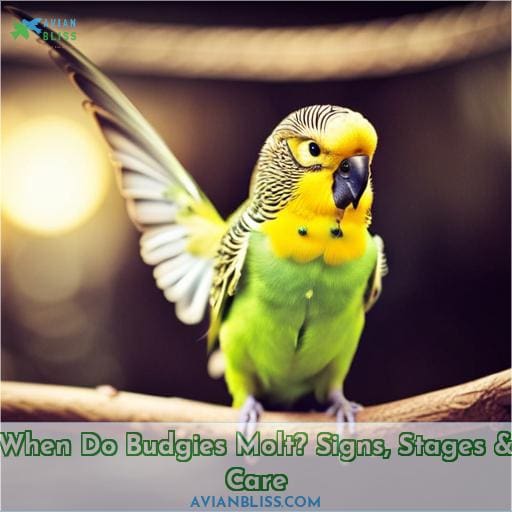 Curious about when your budgie will molt? Understanding the signs, stages, and care involved can help you support your feathered friend during this natural process.
Curious about when your budgie will molt? Understanding the signs, stages, and care involved can help you support your feathered friend during this natural process.
Whether it’s their first juvenile molt at 3-4 months old or a regular molting cycle throughout their life, providing a high-quality diet and creating a comfortable environment are essential for healthy feather growth.
Discover more about budgie molting to ensure your pet’s well-being through every stage of this transformative process.
Table Of Contents
- Key Takeaways
- Normal Budgie Moulting
- Abnormal Budgie Moulting
- Stages of Budgie Moulting
- How to Care for a Moulting Budgie
- Frequently Asked Questions (FAQs)
- How long does the molting process typically last for budgies?
- Are there any specific signs or symptoms that indicate abnormal molting in budgies?
- Can environmental factors such as temperature or lighting affect the timing of a budgie’s molt?
- Are there any dietary changes or supplements that can help support a budgie’s molt?
- Is it normal for budgies to experience any behavioral changes during the molting process?
- Conclusion
Key Takeaways
- Budgies typically molt for around 2 to 3 weeks.
- Abnormal signs of molting in budgies include persistent feather loss without regrowth and multiple bald spots with no pin feather growth.
- Environmental factors such as temperature and lighting can trigger molting in budgies.
- Providing a high-quality diet with essential nutrients and considering supplements like calcium and protein-rich foods can support a budgie’s molt.
Normal Budgie Moulting
During normal budgie moulting, there are specific signs to look out for:
- Feathers on the cage floor
- A scruffy appearance
- The growth of new feathers
The causes of normal budgie moulting can include:
- Environmental changes
- Hormonal fluctuations
- Diet variations
- Simply the natural process of feather replacement.
Signs of Normal Budgie Moulting
Recognizing the signs of normal budgie moulting is important for understanding and caring for your feathered friend during this natural process.
Look out for:
- Loose feathers on the cage floor
- A scruffy appearance
- Irritability in your budgie
New feathers will start to appear, often in the form of pin feathers that are white with a pinkish tinge.
It’s also common to see bald patches or uneven moulting areas.
Remember to provide extra warmth during rapid loss of feathers in cold temperatures and seek veterinary advice if you suspect abnormal molting due to French moult or malnutrition.
Causes of Normal Budgie Moulting
During molting, budgies molt their feathers to replace old ones with new ones.
The causes of normal budgie moulting include:
- Seasonal changes
- Hormone changes
- Diet changes
- Stress
- Parasites
These factors can trigger the natural process of molting in budgies as they adapt to their environment and maintain overall health.
It’s important to provide a balanced diet that includes fresh vegetables for optimal feather growth during this period of transition.
Abnormal Budgie Moulting
If you notice that your budgie is losing feathers, especially if they aren’t regrowing or if there are multiple bald spots with no sign of pin feathers growing, it may be a sign of abnormal moulting. This could indicate underlying health issues such as malnutrition or the presence of parasites.
It’s important to seek veterinary advice in order to determine and address the cause of these abnormalities.
Signs of Abnormal Budgie Moulting
If your budgie is experiencing abnormal moulting, you may notice unusual signs and behaviors in your feathered friend.
Some signs of abnormal budgie moulting include:
- Rapid loss of feathers
- Bald patches
- Uneven moulting areas
These symptoms can be caused by various factors such as malnutrition or conditions like French moult.
It’s important to seek veterinary advice if you observe these abnormalities to ensure the health and well-being of your parakeet.
Causes of Abnormal Budgie Moulting
One possible cause of abnormal budgie molting can be attributed to malnutrition or a lack of essential nutrients in their diet.
- Rapid loss of feathers
- Bald patches
- Uneven, asymmetrical moulting areas
Another cause could be exposure to cold temperatures, which can disrupt the natural molting process.
Additionally, certain conditions such as French moult or the presence of parasites may also contribute to abnormal budgie molting.
It’s important to ensure that your budgie receives a balanced diet with sufficient minerals and nutrients for healthy feather growth.
Stages of Budgie Moulting
During the moulting process, budgies go through three distinct stages.
The first stage involves the loss of feathers as old ones are shed.
This is followed by the growth of pin feathers, which are small and usually white with a pinkish tinge.
Lastly, full new feathers grow in to replace the old ones, completing the moulting cycle for budgies.
Stage 1: Loss of Feathers
Losing feathers is a common occurrence during the first stage of budgie moulting.
This stage, known as Stage 1: Loss of Feathers, marks the beginning of the molting process.
During this time, your budgie will shed its old feathers to make way for new ones.
The number of feathers lost can vary from bird to bird, but it’s normal for them to lose several feathers during this stage.
Feather loss typically starts around 10-12 weeks old and can last approximately three weeks in total.
Stage 2: Growth of Pin Feathers
During Stage 2 of budgie moulting, you’ll notice the growth of pin feathers on your bird’s body.
These new feathers are characterized by their appearance, color, location, and texture.
Pin feathers usually have a white color with a pinkish tinge and may have a black tip.
They can be found all over the bird’s body and feel rough to the touch due to their protective sheaths.
While these growing pin feathers can cause some discomfort for your budgie, it’s important not to disturb or pluck them as they play an essential role in ensuring healthy feather growth during this stage.
Stage 3: Growth of Full New Feathers
As your budgie progresses through the stages of molting, the next phase is the growth of full new feathers.
During this stage, you may notice that your budgie’s pin feathers start to transform into vibrant and healthy plumage.
While growing, pin feathers can appear as small white or pinkish tubes with a black tip.
How to Care for a Moulting Budgie
During your budgie’s molt, it’s important to adopt a high-quality nutritional diet to support their feather growth and overall health.
Providing a balanced mix of seeds, fresh fruits and vegetables, as well as supplements if necessary, can ensure they receive the necessary nutrients.
Additionally, improving their comfort by maintaining warmth in the environment and providing time and space for privacy can help alleviate any discomfort during this period.
Adopt a High-quality Nutritional Diet
To care for your moulting budgie, it’s important to adopt a high-quality nutritional diet.
Include fruits, vegetables, protein sources like eggs or spinach, and provide seeds and nuts as well.
A balanced diet will support the growth of new feathers and overall health during this period.
By providing your budgie with essential nutrients through their diet, you can help them have a smoother molting process and maintain their vibrant plumage.
Improve Comfort
To improve your budgie’s comfort during molting, provide a warm and cozy environment.
- Offer soft bedding for them to rest on.
- Keep their cage clean to prevent any irritants from affecting their sensitive skin.
- Avoid drafts that can cause discomfort, especially during this vulnerable time.
Additionally, giving regular baths can help alleviate itchiness caused by new feather growth.
By taking these steps, you can ensure that your budgie feels safe and comfortable throughout the molting process.
Frequently Asked Questions (FAQs)
How long does the molting process typically last for budgies?
The molting process typically lasts for budgies around 2 to 3 weeks. During this time, they shed their old feathers and grow new ones.
Providing a high-quality diet and creating a comfortable environment can help support your bird during its molt.
Are there any specific signs or symptoms that indicate abnormal molting in budgies?
Abnormal molting in budgies is signaled by:
- Persistent feather loss without regrowth, especially of tail or wing feathers.
- Multiple bald spots with no pin feather growth.
Veterinary advice should be sought in such cases.
Can environmental factors such as temperature or lighting affect the timing of a budgie’s molt?
Environmental factors such as temperature and lighting can indeed influence the timing of a budgie’s molt.
Changes in these conditions may trigger molting, causing the bird to shed old feathers and grow new ones.
Are there any dietary changes or supplements that can help support a budgie’s molt?
To support your budgie’s molt, provide a high-quality diet with essential nutrients.
Consider adding supplements like calcium and protein-rich foods such as hard-boiled eggs, spinach, or broccoli.
This will help promote healthy feather growth during this natural process of renewal.
Is it normal for budgies to experience any behavioral changes during the molting process?
During molting, budgies may exhibit behavioral changes such as:
- Increased irritability
- Restlessness
- A tendency to bite
These behaviors symbolize the bird’s internal struggle for liberation and power as it sheds old feathers to make way for new growth.
Conclusion
To ensure the well-being of your budgie during its molting process, it’s important to understand the signs, stages, and care involved.
Whether it’s a normal molt or an abnormal one, providing a high-quality diet and creating a comfortable environment are crucial for healthy feather growth.
By recognizing the signs and stages of molting, such as the loss of feathers and the growth of new ones, you can support your budgie through this transformative process.
Remember to consult with an avian veterinarian or ornithologist for any concerns or questions you may have.
Rest assured, your budgie will molt in due time, and with proper care, it will emerge with beautiful new feathers.

